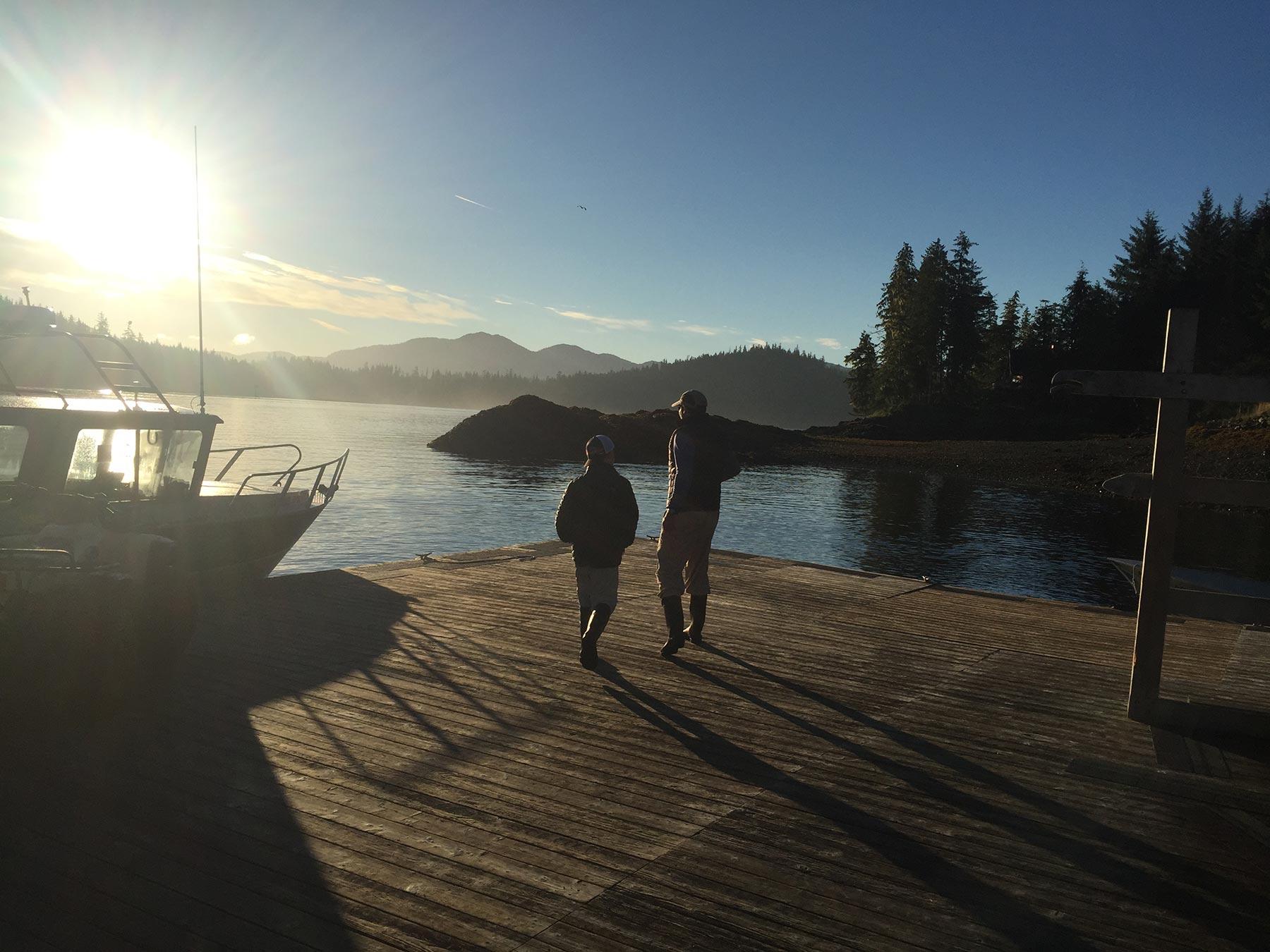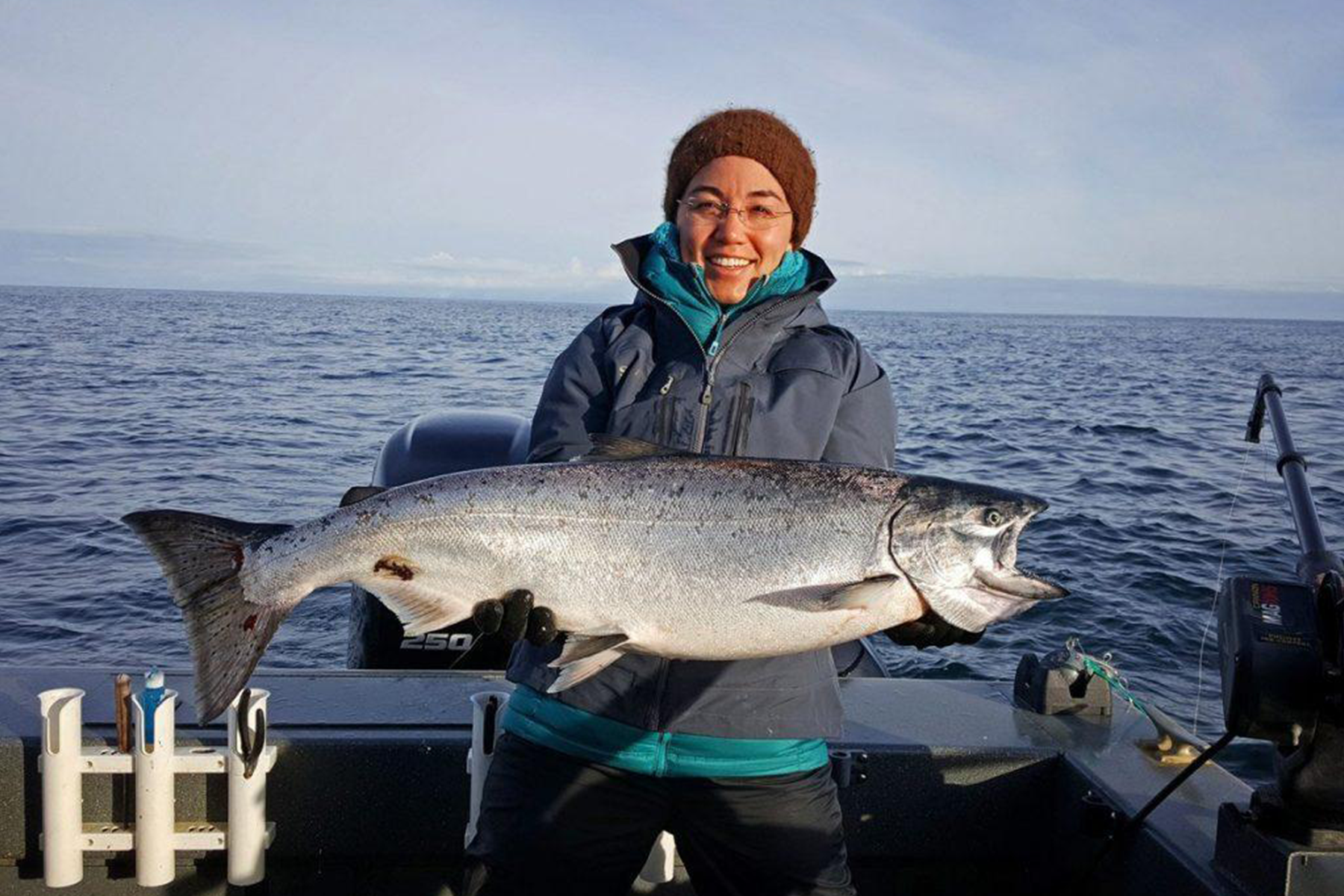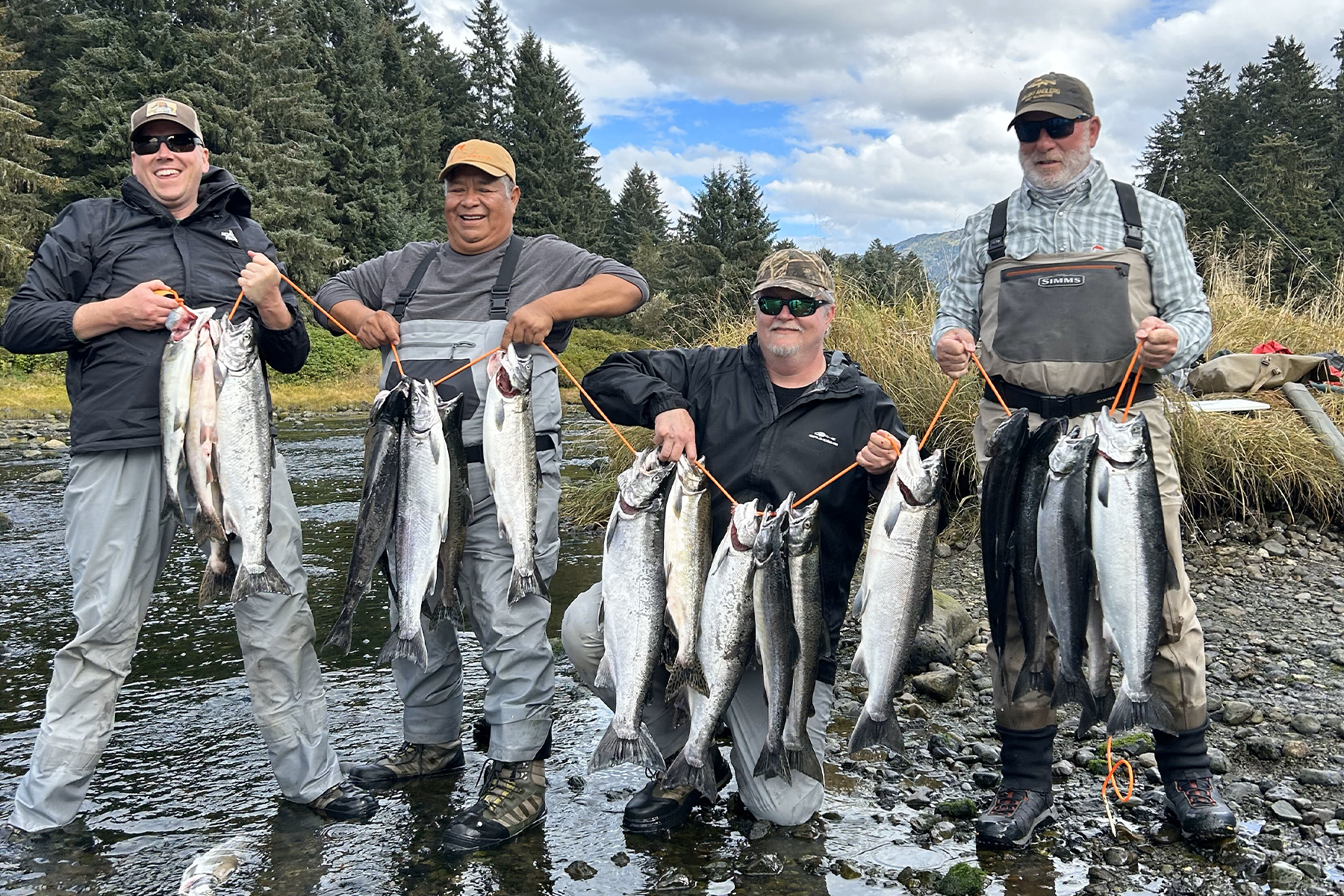
Southeast Alaska Weather
Learn about Southeast Alaska's seasonal weather—useful for planning your trip to Alaska any time of the year.
Southeast Alaska Weather
The climate here in Southeast Alaska is that of a high-latitude rainforest. Weather conditions change frequently, especially during spring and fall months. Conditions are generally comparable to that of Seattle. Temperatures in spring and fall range from 35-65 degrees Fahrenheit, while summer temperatures range from 45-75 degrees (reference our Packing List for clothing and personal item suggestions).
Alaska's Boardwalk Lodge is located on an oceanfront property along Thorne Bay, Prince of Wales Island, Alaska - one of the many protected bays and inlets that make saltwater fishing conditions here so pleasurable. Due to our prime location and temperate climate, the lodge has rarely had a non-fishing day since opening in 1990.
Current Weather Conditions
What Time Zone is Alaska in?
Alaska observes Daylight Savings Time in the United States. We're located in the Alaska Daylight Time Zone (AKDT is 1 hour behind Pacific). Find times for Southeast Alaska sunrise and sunset.
Southeast Alaska Weather by Season
Each season in Southeast Alaska offers its own unique experiences and weather patterns, from the mild and lush summers to the serene, snowy winters. As you plan your Alaska adventure, consider the distinct qualities of each season to fully embrace and enjoy what this magnificent region has to offer at different times of the year.
Southeast Alaska in Spring
In Southeast Alaska, spring brings a noticeable change in the weather as the region transitions from the harsh conditions of winter to the milder temperatures of summer. During this time, which spans from March through May, the weather can vary quite a bit.
Temperatures in Southeast Alaska during the spring months gradually rise, with averages ranging from the mid-30s to the mid-50s Fahrenheit. The increasing warmth slowly begins to melt the winter snow, especially at lower elevations and in coastal areas. However, in higher elevations and more inland locations, snow can linger, sometimes resulting in late-season snowfall or mixed precipitation.
Rain is a common for Southeast Alaska's spring weather. The region, known for its high annual precipitation, experiences frequent rain showers during these months. These showers contribute to the lush greenery and blooming of wildflowers, making spring an excellent time for nature lovers to visit. However, the weather can be unpredictable, with sunny days quickly turning to rain, so it's advisable for visitors to come prepared with waterproof gear and layers.
The lengthening days are another hallmark of spring in Southeast Alaska. The region begins to enjoy more daylight compared to the darker months of winter, with daylight hours increasing significantly as the season progresses. This extended daylight is particularly noticeable as the summer solstice approaches in June. The longer days are perfect for outdoor activities like hiking, wildlife watching, and early-season fishing, as the natural world of Southeast Alaska awakens from its winter slumber.
Southeast Alaska in Summer
Southeast Alaska's summers, spanning from June through August, are known for relatively mild and enjoyable weather, making it a favorite time for visitors and locals alike. During these months, the region experiences its warmest temperatures of the year, though it's important to note that 'warm' in Southeast Alaska is cooler compared to many other places. Temperatures typically range from the mid-50s to the mid-70s Fahrenheit, creating a comfortable climate for a variety of outdoor activities.
The summer weather in Southeast Alaska is characterized by its longer, sunnier days, especially around the summer solstice in late June, which marks the longest day of the year. These extended periods of daylight provide ample opportunity for exploring the stunning natural landscapes, from the lush rainforests to the majestic glaciers. While the region is known for its frequent rainfall, summer tends to be drier than other seasons, though rain showers are still common and can occur unexpectedly. This mix of sun and rain keeps the landscape vibrant and green, enhancing the region's natural beauty.
The pleasant summer temperatures and relatively stable weather are ideal for outdoor pursuits such as hiking, fishing, kayaking, and wildlife watching. Southeast Alaska's waters are bustling with marine life, including whales, seals, and a variety of fish, making it a prime time for fishing and sightseeing cruises. The clear, mild days also offer excellent conditions for visiting famous sites, like the Misty Fjords. As such, summer in Southeast Alaska is not just about warmer weather; it's a season that brings the region to life, offering visitors a chance to experience its unique blend of natural beauty and adventure.
Southeast Alaska in Fall
Fall in Southeast Alaska, which spans from September through November, ushers in a noticeable shift in weather as the region transitions from the mild temperatures of summer to the cooler, wetter conditions of winter. During this time, temperatures gradually decrease, ranging from the low 40s to mid-50s Fahrenheit, with the cooler air hinting at the approaching winter.
This season is marked by an increase in rainfall, making it one of the wetter periods of the year in Southeast Alaska. The frequent and often heavy rain contributes to the region's lush, rainforest environment, and visitors should be prepared for wet conditions by packing appropriate rain gear. Despite the rain, fall can be a beautiful time in Southeast Alaska, as the changing foliage paints the landscapes in vibrant hues of yellow, orange, and red, offering spectacular scenic views, especially in the inland and higher elevation areas.
As the days shorten, the extended daylight hours of summer give way to earlier sunsets, reducing the amount of daylight for outdoor activities. However, the fall season also brings a quieter, more serene atmosphere to the region, as the summer tourist crowds dwindle. This makes it an ideal time for those seeking a more peaceful experience of the area's natural beauty. For wildlife enthusiasts, fall is an excellent time to visit. The animals, like bears and eagles, are actively preparing for the winter months.
Southeast Alaska in Winter
Winter in Southeast Alaska, spanning from December through February, brings a distinct transformation to the region's climate. The temperatures during these months are usually cold, often hovering around the mid-20s to mid-30s Fahrenheit. These chilly conditions are accompanied by shorter days, with limited daylight hours due to the high latitude of the region, especially around the winter solstice in late December, which is the shortest day of the year.
Snowfall is a prominent feature of winter in Southeast Alaska, although the amount can vary significantly. The coastal areas typically receive moderate snowfall, while the inland and higher elevation areas can experience heavier snow. The snow blankets the landscapes, creating picturesque winter scenes and offering opportunities for winter sports, such as skiing and snowshoeing. However, it's important to note that Southeast Alaska's proximity to the ocean can sometimes lead to mixed precipitation, including rain and sleet, particularly in lower elevation and coastal areas.
The winter weather also brings with it the possibility of high winds and storms, particularly when weather systems move in from the North Pacific. These conditions can sometimes lead to challenging travel and outdoor activities, so it's important that visitors and locals stay informed about the latest weather forecasts and be prepared for rapidly changing conditions.
Despite the cold and snow, winter in Southeast Alaska has its unique allure. The serene beauty of the snow-covered landscapes, the quietness of the season, and the possibility of seeing the northern lights on clear, dark nights make it a magical time for those who appreciate the stark beauty of winter in the north.
When is the Best Time of Year to Visit Southeast Alaska for Good Weather?
The best time to visit Southeast Alaska for good weather is typically during the summer months, from June to August. During this period, you can expect milder temperatures and longer daylight hours, making it ideal for outdoor activities and exploring the region.
- Temperature: The average summer temperature in Southeast Alaska is relatively cool, but pleasant, ranging from 45 to 75 degrees Fahrenheit. This cool summer weather is perfect for enjoying outdoor activities without the discomfort of high heat.
- Daylight: Summer in Southeast Alaska is known for extended daylight hours, especially around the summer solstice in late June, when it's the longest day of the year. This extended sunlight allows for more time to explore the outdoors, whether it's hiking, fishing, or sightseeing.
- Weather Conditions: Summer tends to have drier and more stable weather compared to other times of the year. While rain showers are still possible, they are generally less frequent and intense than in fall or spring.
- Nature and Wildlife: This time is also great for viewing Alaska's stunning natural landscapes, from glaciers like the Mendenhall Glacier to diverse wildlife. The milder weather allows for more comfortable exploration of these natural wonders.
- Alaskan Cruises and Adventure: Many Alaskan cruises operate during these months, taking advantage of the favorable weather and offering a variety of sightseeing and adventure options.
However, it's important to note that weather can be unpredictable, so it's wise to be prepared for a range of conditions. Packing rain gear and layers is recommended, even in summer. And, while summer offers the best weather, it's also the busiest tourist season, so you should plan your trip in advance.
When is the Best Time of Year to Visit Southeast Alaska for Fishing?
The best time for fishing in Southeast Alaska generally depends on what type of fish you're aiming to catch. Here's a quick breakdown:
- King Salmon (Chinook): The peak season for King Salmon is usually from May to early July. This is when they are most abundant and large in size.
- Silver Salmon (Coho): For Silver Salmon, the best time is from July to September. They are known for their energetic fight, making them a favorite among anglers.
- Pink Salmon (Humpy): Pink Salmon are most plentiful in July and August. They are the smallest of the Pacific salmon species but are abundant.
- Chum Salmon (Dog): Chum Salmon fishing is best from July to August. They are known for their impressive size and strength.
- Halibut: Halibut can be caught from May through September, with the peak months being June, July, and August. They are one of the most sought-after fish due to their size and taste.
- Rainbow Trout, Dolly Varden, and Steelhead: These species can be found throughout the year, but the best fishing is usually in the spring (April and May) and fall (September and October).
Keep in mind that fishing regulations and seasons can change, so it's a good idea to check the latest news and forecasts from the National Weather Service or the Alaska Department of Fish and Game before planning your trip. This ensures that you're fishing legally and at the best times for specific species.
How Much Does It Rain in Southeast Alaska?
Southeast Alaska is known for its high levels of rainfall, primarily due to its temperate rainforest climate. The region receives a significant amount of rain each year, making it one of the wettest areas in North America.
The average annual precipitation in Southeast Alaska can vary widely depending on the specific location. Coastal areas, especially those closer to the Gulf of Alaska, typically receive more rain. On average, many areas in Southeast Alaska receive between 60 to 140 inches (1,500 to 3,500 mm) of precipitation annually.
This high level of precipitation contributes to the lush, green landscapes that define the region and supports its rich biodiversity, including extensive temperate rainforests. However, it also means that outdoor activities in Southeast Alaska are often subject to rainy conditions, and locals and visitors alike need to be prepared for wet weather.
What Kind of Clothing Should I Pack for a Trip to Southeast Alaska?
Packing for a trip to Southeast Alaska requires preparing for a variety of weather conditions, as the region is known for its often unpredictable climate. Here are a few essential items to include:
- Layers: The key to comfort in Southeast Alaska's ever-changing climate is layering. Start with a moisture-wicking base layer to keep you dry, add an insulating middle layer like a fleece or wool sweater, and top it with a waterproof and windproof outer layer.
- Waterproof Rain Gear: Given the high likelihood of rain, a good quality waterproof jacket and rain pants are essential. Ensure they are breathable to maintain comfort during activities.
- Footwear: Waterproof hiking boots are ideal for exploring the varied terrain. They provide support and keep your feet dry. Also, consider packing water-resistant shoes for casual wear and rubber boots if you plan on fishing or boating.
- Warm Hat and Gloves: Even in summer, mornings and evenings can be cool, especially on the water or at higher elevations. A warm hat and gloves can make your experience more comfortable.
- Comfortable, Durable Clothing: Pack clothing that can withstand outdoor activities. Quick-dry materials are beneficial, especially for pants and shorts.
- Extra Socks: Bring enough socks, preferably wool or a wool blend, which can keep your feet warm and dry.
- Sun Protection: While not always sunny, UV protection is essential. Pack sunglasses, a brimmed hat, and sunscreen.
- Backpack: A comfortable, waterproof backpack is useful for day trips to carry essentials like water, snacks, a camera, and extra clothing.
The weather can change quickly, so it's always better to be prepared for everything from rain to sunshine.
How Does the Weather in Southeast Alaska Compare to Other Parts of Alaska?
Southeast Alaska has a milder climate, with higher rainfall and less extreme temperatures compared to other regions.
Interior Alaska, like Fairbanks, experiences greater temperature extremes, with very cold winters and warmer summers. It's also a lot drier.
Southcentral Alaska, including Anchorage, has a mix of ocean and land influences, leading to cooler winters and moderately warm summers with more snowfall than Southeast Alaska.
Northern Alaska, such as Utqiaġvik, is marked by an Arctic climate with very long, extremely cold winters and short, cool summers, and it has low precipitation but significant daylight variation.
Can the Northern Lights Be Seen in Southeast Alaska?
Seeing the Northern Lights in Southeast Alaska is less common and less predictable than in Alaska's northern regions, but it's still possible, especially during periods of high solar activity. The best chances are in the winter months, from late September to early April, when nights are longer and darker.
To further increase the likelihood of a seeing the Northern Lights, it's highly recommended that you venture away from city lights into more remote or rural areas. While Southeast Alaska isn't as renowned for Northern Lights viewing as places like Fairbanks, with the right conditions, seeing this spectacular natural phenomenon is possible.
1-907-204-8832
support@boardwalklodge.com
Alaska's Boardwalk Lodge 1 Cook's Cove Thorne Bay, AK 99919
Monday - Friday :
8:00 AM - 9:00 PM

About
Support
Boardwalk Lodge Supports









Our Partners











